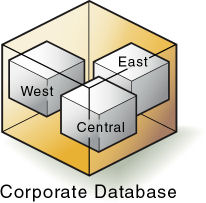Use Calculation Scripts on Partitions
A partitioned Essbase application can span multiple servers, processors, or computers. You can achieve significant calculation performance improvements by partitioning applications and running separate calculations on each partition.
Write Calculation Scripts for Partitions
When writing calculation script for transparent or replicated partitions, review these guidelines:
-
Evaluate the performance impact on the overall cube (database) calculation. To improve performance, you can:
-
Redesign the overall calculation to avoid referencing remote values that are in a transparent partition in a remote cube.
-
Dynamically calculate a value in a remote cube.
-
Replicate a value in the cube that contains the applicable formula.
For example, if replicating quarterly data for the Eastern region, replicate only the values for Qtr1, Qtr2, Qtr3, and Qtr4, and calculate the parent Year values locally.
-
-
Ensure that a referenced value is up-to-date when Essbase retrieves it. Choose one of the options previously discussed (redesign, dynamically calculate, or replicate) or calculate the referenced cube before calculating the formula.
Control Calculation Order for Partitions
You must calculate the partitioned cubes in a specific order to ensure that Essbase calculates the required results.
The following image illustrates partitions in which you view information from the West, Central, and East databases transparently from the Corporate database:
Figure 23-1 Calculating Partitions

West, Central, and East contain only actual values. Corporate contains actual and budgeted values. Although you can view West, Central, and East data in the Corporate database, the data exists only in the West, Central, and East —it is not duplicated in Corporate.
Therefore, when Essbase calculates Corporate, it must take the latest values from West, Central, and East. To obtain the required results, you must calculate West, Central, and East before you calculate Corporate.